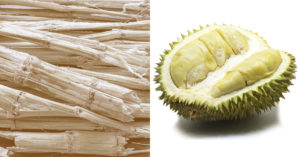Young inventors use food waste to create sustainable water filter
The winners of this year’s Stockholm Junior Water Prize developed a more sustainable way to produce a material used in water filters. Using the rinds of durians and waste from sugarcane, Caleb Liow Jia Le (left in photo), Johnny Xiao Hong Yu (right) and Ho Shane found a safer way to create reduced graphene oxide. Learn how they did it.
The three 16-year-old students are in their fourth year of high school in Singapore, and won with their project: “A novel, eco-friendly synthesis of reduced graphene oxide (rGO) from durian rind and sugarcane bagasse for water filters”.
Could you describe what your project is about?
Caleb: For our project we used two very common types of food waste in Singapore. Durian is a spiky kind of fruit. The yellow part of the fruit is eaten, and the husk is thrown away, so we used that part. We also used sugarcane bagasse, which is the fiber waste left over when juice is pressed from sugarcane. We made this waste into a material called reduced graphene oxide.
Johnny: Reduced graphene oxide is able to remove heavy metal irons and organic dyes from water. It can be used in water filters for water purification.

Where did you get your inspiration for this project?
Caleb: We produce a lot of different kinds of waste, from electronics, plastics and food. I wanted to see how we could turn this waste that we would normally dispose of into something could potentially be useful, help the community, and make people’s lives better.
Johnny: I’m very interested in chemistry and applying chemistry to solve real-world problems. In this case, creating chemicals that can actually address the concerns of the community.
What is the traditional way to make reduced graphene oxide?
Johnny: The current way is to use chemicals in a process called Hummers’ method, developed in 1958. It uses a variety of chemicals and toxic compounds in a very complicated process. While our method just uses food waste.
Is the use of reduced graphene oxide widespread?
Caleb: Reduced graphene oxide is actually a very versatile material. It is widely used in electronics because of its conductivity. Since it has a similar structure to graphene, it is able to conduct electricity very well. But it is also slowly being adopted in the area of water purification, due to its suitable properties.
Did you actually make a water filter using your material?
Johnny: Yes, we made two different types of filters. Reduced graphene oxide is a black powder, similar to activated charcoal. We took this powder and coated a mixed cellulose ester filter paper with it to act as a filter. The second type we made is a more traditional column filter, where we packed the reduced graphene oxide powder into a column. Both types of our filters filtered out more than 95% of heavy metal irons and organic dyes, which is comparable to activated charcoal.
Could any kind of organic waste be used in your process?
Caleb: Both durian rinds and sugarcane bagasse have a lot of cellulose in them, so that makes them suitable for our synthesis process. To synthesize reduced graphene oxide in our method, we carbonized and oxidized cellulose in a furnace, and then we added a reducing agent to make it reduced graphene oxide. So other fruits that contain cellulose could also be converted, which can be explored further.
What kind of water challenges do you have in Singapore?
Johnny: Singapore relies on four main sources of water: water catchment, like reservoirs; desalination, since we are surrounded by the sea; NEWater, which is our form of recycled water; and then we have imported water that we buy from our neighbors.
Right now, Singapore is still quite reliant on imported water. The main concern for Singapore is finding ways to make us more self-sufficient. This can mean reducing the cost of desalination, recycling water, and finding new ways of getting fresh water. Our project is in the area of treating and recycling water.
Since water is a limited resource in Singapore, do you think people there are more water conscious?
Johnny: We can still take water for granted, since you just turn on the tap and drink, but recently there has been an increase in water taxes. This has made everyone more conscious of the water situation.
Caleb: The water taxes hadn’t increased in a long time, so everyone was wondering why it happened.
Are many people in Singapore aware of the NEWater recycling program?
Johnny: Yes, when you are using recycled water you need to promote awareness. People know it is sewage water, so it requires a lot of convincing.
Caleb: In our elementary schools, when you are about 7 to 12 years old, almost all students go on a study visit to a NEWater plant. This helps younger generations get more interested in water issues.
About the Stockholm Junior Water Prize
The prize is organized by the Stockholm International Water Institute and sponsored by Xylem. Learn more about the prize and the 2018 finalists.
Congratulations to this year’s winners!

